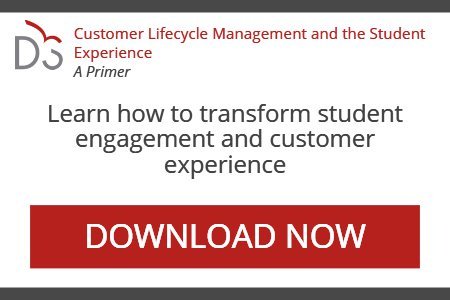Published on
Looking to the Student-Centered Future of Higher Education

In 2018, the postsecondary industry underwent a unique evolution in terms of student demographics and learning innovation. Students are no longer treated as a monolithic entity. Instead, colleges and universities are shifting towards a human-centered approach to change management—an evolution that will impact the industry in coming years. In this interview, Louis Soares reflects on some of the broad shifts that occurred across the postsecondary environment in 2018 and shares his insights on how this space will continue to evolve through 2019 and beyond.
The EvoLLLution (Evo): How has the higher education industry evolved in 2018?
Louis Soares (LS): We’ve seen a continuing evolution in learning analytics over the past year. There’s still a lot of variability in their application, but we’re starting to see analytics become more deeply embedded in the design of postsecondary learning. In the public dialogue, we’re seeing an emergence of people looking for alternatives to postsecondary education, like apprenticeship opportunities, and we’re seeing a shift in how higher education defines its value in the midst of such a conversation.
Like analytics, initiatives around competency-based education (CBE) are becoming more deeply embedded in higher ed. We’re still figuring out what scale looks like in that space. There’s a growing interest in learning as a result of those early adopters and innovators.
We’re also starting to see new partnerships around innovations like CBE emerge in organizations that are external to postsecondary institutions, such as bootcamps. I’ve been wondering what that looks like over the long term. Is postsecondary education morphing into a core, with services offered around the edges of that core? What does that look like over time?
There are also growing concerns about whether innovations are being administered and deployed in equitable ways. Who’s being served? Is the quality of a CBE program the same as a traditional academic program? These are live trends. A lot of social activists on American campuses in the last few years raised questions around the idea that, if we’re innovating and creating alternative forms of postsecondary education, who’s being served by them? Importantly, we began to examine whether quality levels are the same for all postsecondary learners.
Evo: The theme that seems to be underpinning these trends is the idea of variable student demand, and the impact that it has on how institutions are operating. If students are looking for alternatives to postsecondary education altogether, what does that mean for the design, the value proposition and the mission of the institution? Does traditional higher ed itself need to evolve to compensate for that shift?
LS: Human-centered design has become generally popular, and I’ve been finding that more and more institutions are taking a student-centered approach to change management. There needs to be an understanding of an institution’s value proposition. If an institution has 18,000 students, they’re not going to create 18,000 value propositions, but they probably can develop 20.
Part of the shifting journey of enrollment management in higher education right now lies in gaining a more granular understanding about what your value proposition is, and for whom. That is evolving. I don’t know if we’re moving towards full personalization of postsecondary education yet, but we are moving towards a deeper understanding of the limited set of value propositions that an institution offers and building processes and programs around that set.
We’re not yet serving the single student, but we’re not serving the 18,000 either. We’ll start developing archetypes for whom the value propositions apply, and that will, over time, determine what program delivery looks like. I don’t want to overstate that, because my specific point is that the reason human-centered, or student-centered, design is becoming really interesting in higher education is because of that narrowing in on a specific value proposition. It’s a tool-set that colleges are finding useful and can improve upon as well.
Evo: What are some of the key opportunities on the horizon for postsecondary leaders in 2019?
LS: Whether it’s from general market forces driving change, or by an institutional practice that helps you more deeply unpack value propositions, you’re going to see institutional leaders needing far more coordinated, team-based management at the cabinet level on a campus. At the very least, this will involve presidents, provosts, chief innovation officers and CFOs. If student affairs is independent, you’re going to need far more coordinated team-based leadership there, too.
A core of your leadership practice will have to be driven by change management. Change is going to be with you, whether it’s driven by outside forces or internal practice. Change is constant, and you need senior leadership teams that understand change management over the long term. I see that growing as a leadership and management practice in 2019.
Evo: What are some of the threats that college and university leaders to need to be conscious of going into 2019?
LS: First, we have to look at the market factors affecting the cost of higher education. This includes student debt and public policymakers, who are looking at higher ed and saying, “Okay, show me the value.” We need to be able to articulate the value of what we’re offering at a high level.
Second, there seems to be a heightened challenge around the idea that folks have been left behind by the globalizing economy. How do you understand your value proposition for those people? Who can best meet their needs? The challenge of demand has always been with higher ed, but now it’s accompanied by a skepticism about whether or not higher ed can meet the needs of a diverse population. This is tied to emerging public narratives about debt and affordability. I’m not saying that I agree with those public narratives—I’m saying that two threats facing the industry are this underlying skepticism, and a growing demand from post-traditional students.
Finally, more practically, how do you actually meet the needs of those post-traditional folks? If you’re not great at it and it fits within your academic mission, how do you improve?
Evo: So much of what we see in the continuing and professional education space addresses these questions about adapting programming to better suit the needs of non-traditional students. Do you see a changing role for continuing education (CE) divisions as institutions begin to recalibrate to compete in this new environment?
LS: The market intelligence that you can get from a CE shop is always useful, but you need to be mindful of the fact that new isn’t always better. If a core value proposition of the enterprise involves serving a traditional student base well and it’s accomplishing that mission relatively well, it’s possible to look at how that more traditional model can be enhanced or augmented by the expertise of the CE space. This is a different approach than looking at the traditional model and thinking, “Well, it must be broken just because it’s the old model.”
You have to look for places where the knowledge from each can enhance the other, rather than thinking that they’re going to disrupt each other by default. This doesn’t mean that there aren’t going to be differences. There is still a large and robust market for more traditional programs in higher ed. They can exist on the same campus. How can we learn from the other where it merits it? For example, look at value proposition honing. Even if your residential model is working really well, I think that if you really drill down, you can’t find one single value proposition for all those students—you’ll probably find some archetypical value propositions based on the ways that your CE shop thinks about delivering value in a much more competitive CE space, around post-traditional and occupationally-oriented certificates.
If your CE unit is good at understanding what the market will bear, it can help you determine those value propositions for traditional units. If you’ve got 5,000 undergrads, maybe there are ten value proposition archetypes you can create. A CE leader can teach you how to find them.
Evo: It’s not about scrapping what existed and coming up with something new. It’s about creating robust, alternative pathways and access points for people who weren’t served properly by what was there before.
LS: Yes. It’s also a constant enhancement of your underlying business process. It’s not broken, but you can always make it better. You can always be evolving. Viewed that way, you can leverage what each side—CE and traditional—knows for those incremental advancements.
Evo: Looking five years ahead, what do you think will be some of the norms and standards in higher education in 2024? What will be different and what will stay fundamentally the same?
LS: We’re in a moment where our understanding of learning—where and how it happens, and why it matters—is evolving. It has been for a long time. We’re truly moving from a knowledge economy to a learning economy.
Underpinning that shift is the fact that the average learning intensity of daily life is going up, inclusive of formal studying. Education doesn’t just happen in formal higher ed contexts. If someone is learning meaningful things every day for what they need to do next, and they come to us for formal education as the final piece of the puzzle, we have to understand not just what they already know but also their learning identity. How are do they learn? That learning identity is formed by how they engage in learning in their work life, their family life, in formal environments and as a citizen. That learning identity is connected to different knowledge communities, along a continuum from more formally structured to less formally structured learning opportunities.
As an individual interacts with those knowledge communities, higher education can take on a different role: Connecting the learning ecosystems that those knowledge communities create for the learner. How does higher ed help us understand Learner X’s learning identity? What are the three or four knowledge communities they’re embedded in? How do we optimize their human capital based on that information?
There are different players that could figure out the answers to those questions, but higher ed is well placed to do it in a learning economy. Corporations could do it but I don’t know whether that’s going to work. Higher education is already doing it: Delivering education in a structured environment; taking a learner’s core capabilities and using it to create a networked understanding of learning.
This ability to map learning across networks is something that we have digital capability for right now, but there are no bodies yet that fully embrace that as their mission. We map learning to optimize human capital. Higher education institutions could fill that role.
That said, we’ll still be offering programs and courses. We’ll become increasingly hybrid—more so than we already are. Higher education is not online versus face-to-face, because face-to-face courses have plenty of interaction with technology, even now. This trend is going to continue, all the way to getting a bachelor’s degree fully online.
Experiential education is a place to look for growth too. Not just traditional models—the actual discipline of understanding experiential education is going to become much more important, because when you look at skills gaps data, it doesn’t matter who’s offering those experiences. It could be World Economic Forum; it could be Burning Glass. Many of the skills in question, whether you call them business skills or soft skills, are gained with use. I anticipate that the current workplace learning dialogue is going to evolve into one where learners are told, “There are certain skills that you learn in applied settings, regardless of where you are in your formal postsecondary journey.” We need to go much deeper into those. Places like Northeastern University or Drexel are really innovating in this regard. What can we learn from them that will help us extend the model further?
Evo: How you see the role of postsecondary institutions evolving as the industry changes over the coming years?
LS: I see the next 10 to 20 years as a time of robust institutional creativity. There are a lot of really innovative people on campuses, and there’s been a lot of experimentation over the last 20 years. That’s all going to converge in the next 20 years. We’re going to see institutions staying in that core of change for longer periods of time, even though it’s challenging to reshape or re-envision what you do. I’m heartened that that level of creativity exists to help to transform higher ed from within.
Second, learning as a fundamental ecosystem is being reshaped. As learning becomes more hybrid, the set of questions that we’ll ask about, for example, a typical Carnegie classification, will start to look different in practice. That’s likely to cause some confusion, but as long as we stay in that generative space, it’ll be healthy. I feel a moment of creativity is coming because of all this experimentation. There are so many new tools and ways of thinking about postsecondary education that have been brought to light in the last 15 or 20 years. Part of the excitement of the next 20 years is going to be answering the question of how we mix and match and apply those new tools and resources.
While there’s always going to be new knowledge and new tools, the level of our use of technology in the learning process, the granularity of understanding learning, and change management strategies will continue to change. You add those three together and it allows you to start reimagining different ways for institutions to do their work, and perhaps even envision new institutional forms.
This interview has been edited for length and clarity.




